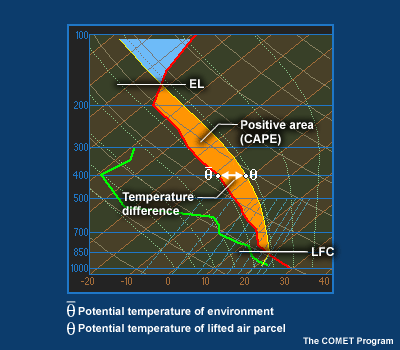CAPE

A more complete estimate of buoyant energy can be computed by determining the temperature difference between the ascent path and the environment at all levels from the LFC up through the equilibrium level. When we sum up all of these temperature differences, we arrive at a number equal to the positive area between the two curves, as shown in this figure. This area provides a measure of the integrated effects of the potential temperature differences between the rising parcel and its environment. The quantitative measure of this positive area is CAPE, or convective available potential energy. CAPE is measured in units of joules per kilogram (J/kg). Most sounding programs calculate CAPE.
When calculating CAPE, we normally lift a parcel that reflects the mean values of the temperature and moisture in the lowest 50 to 100 mb. This layer represents the average heat and moisture conditions fueling convective storms.
The environmental CAPE for convective storms is often in the range of 1000-2000 J/kg. However, values higher than 5000 J/kg sometimes occur.
Remember, you should always use CAPE in conjunction with a full sounding so that you can monitor the strength of low-level inversions and the position of the LFC, or other factors related to the vertical distribution of CAPE that could also modulate convection.